
The Canterbury Tales is a collection of twenty-four stories that runs to over 17,000 lines written in Middle English by Geoffrey Chaucer between 1387 and 1400. It is widely regarded as Chaucer's magnum opus. The tales are presented as part of a story-telling contest by a group of pilgrims as they travel together from London to Canterbury to visit the shrine of Saint Thomas Becket at Canterbury Cathedral. The prize for this contest is a free meal at the Tabard Inn at Southwark on their return.

Yeoman is a noun originally referring either to one who owns and cultivates land or to the middle ranks of servants in an English royal or noble household. The term was first documented in mid-14th-century England. The 14th century also witnessed the rise of the yeoman longbow archers during the Hundred Years' War, and the yeoman outlaws celebrated in the Robin Hood ballads. Yeomen also joined the English Navy during the Hundred Years' War as seamen and archers. In the early 15th century, yeoman was the rank of chivalry between page and squire. By the late 17th century, yeoman became a rank in the Royal Navy for the common seamen who were in charge of ship's stores, such as foodstuffs, gunpowder, and sails.

"The Parson's Tale" seems, from the evidence of its prologue, to have been intended as the final tale of Geoffrey Chaucer's poetic cycle The Canterbury Tales. The "tale", which is the longest of all the surviving contributions by Chaucer's pilgrims, is in fact neither a story nor a poem, but a long and unrelieved prose treatise on penance. Critics and readers are generally unclear what rhetorical effect Chaucer may have intended by ending his cycle in this unlikely, extra-generic fashion.

"The Miller's Tale" is the second of Geoffrey Chaucer's Canterbury Tales (1380s–1390s), told by the drunken miller Robin to "quite" "The Knight's Tale". The Miller's Prologue is the first "quite" that occurs in the tales.

"The Wife of Bath's Tale" is among the best-known of Geoffrey Chaucer's Canterbury Tales. It provides insight into the role of women in the Late Middle Ages and was probably of interest to Chaucer himself, for the character is one of his most developed ones, with her Prologue twice as long as her Tale. He also goes so far as to describe two sets of clothing for her in his General Prologue. She holds her own among the bickering pilgrims, and evidence in the manuscripts suggests that although she was first assigned a different, plainer tale—perhaps the one told by the Shipman—she received her present tale as her significance increased. She calls herself both Alyson and Alys in the prologue, but to confuse matters these are also the names of her 'gossib', whom she mentions several times, as well as many female characters throughout The Canterbury Tales.
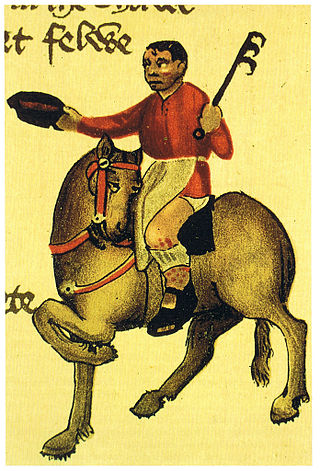
"The Cook's Tale" is one of the Canterbury Tales by Geoffrey Chaucer. It breaks off after 58 lines and was presumably never finished, although some scholars argue that Chaucer deliberately left the tale unfinished. The story starts telling of an apprentice named Perkyn who is fond of drinking and dancing. Perkyn is released by his master and moves in with a friend who also loves to drink, and whose wife is a shopkeeper whose real occupation is that of a prostitute.
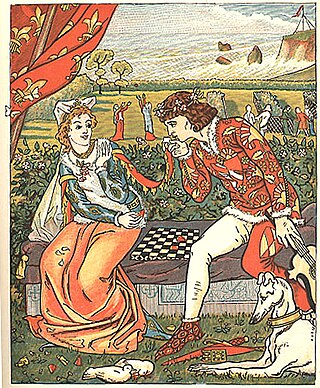
"The Franklin's Tale" is one of The Canterbury Tales by Geoffrey Chaucer. It focuses on issues of providence, truth, generosity and gentillesse in human relationships.

The General Prologue is the first part of The Canterbury Tales by Geoffrey Chaucer. It introduces the frame story, in which a group of pilgrims travelling to the shrine of Thomas Becket in Canterbury agree to take part in a storytelling competition, and describes the pilgrims themselves. The Prologue is arguably the most familiar section of The Canterbury Tales, depicting traffic between places, languages and cultures as well as introducing and describing the pilgrims who will narrate the tales.

"The Manciple's Tale" is part of Geoffrey Chaucer's The Canterbury Tales. It tends to appear near the end of most manuscripts of the poem, and the prologue to the final tale, "The Parson's Tale", makes it clear it was intended as the penultimate story in the collection. The Manciple, a purchasing agent for a law court, tells a fable about Phoebus Apollo and his pet crow, which is both an origin myth explaining the crow's black feathers and a moralistic injunction against gossip.

"The Second Nun's Tale", written in late Middle English, is part of Geoffrey Chaucer's The Canterbury Tales. Narrated by a nun who remains unnamed, it is a hagiography of the life of Saint Cecilia.

"The Shipman's Tale" is one of The Canterbury Tales by Geoffrey Chaucer.
The Legend of Good Women is a poem in the form of a dream vision by Geoffrey Chaucer during the fourteenth century.

Projection was the ultimate goal of Western alchemy. Once the philosopher's stone or powder of projection had been created, the process of projection would be used to transmute a lesser substance into a higher form; often lead into gold.
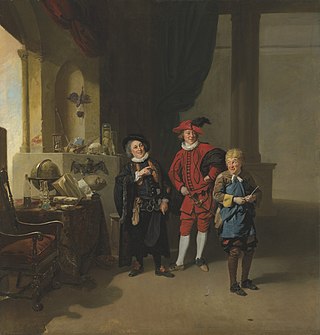
The Alchemist is a comedy by English playwright Ben Jonson. First performed in 1610 by the King's Men, it is generally considered Jonson's best and most characteristic comedy; Samuel Taylor Coleridge believed that it had one of the three most perfect plots in literature. The play's clever fulfilment of the classical unities and vivid depiction of human folly have made it one of the few Renaissance plays with a continuing life on stage, apart from a period of neglect during the Victorian era.
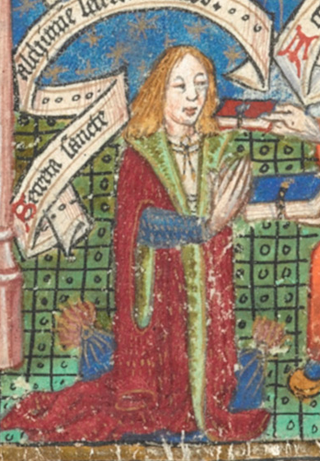
Thomas Norton was an English poet and alchemist best known for his 1477 alchemical poem, The Ordinal of Alchemy.
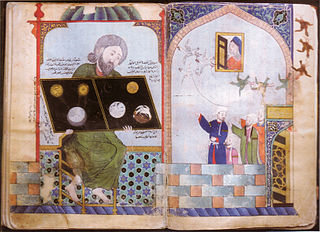
Muḥammad ibn Umayl al-Tamīmī, known in Latin as Senior Zadith, was an early Muslim alchemist who lived from c. 900 to c. 960 AD.

Alchemy has had a long-standing relationship with art, seen both in alchemical texts and in mainstream entertainment. Literary alchemy appears throughout the history of English literature from Shakespeare to modern Fantasy authors. Here, characters or plot structure follow an alchemical magnum opus. In the fourteenth century, Chaucer began a trend of alchemical satire that can still be seen in recent fantasy works like those of Terry Pratchett.
The Prologue and Tale of Beryn are spurious fifteenth century additions to Geoffrey Chaucer's Canterbury Tales. They are both written in Middle English.
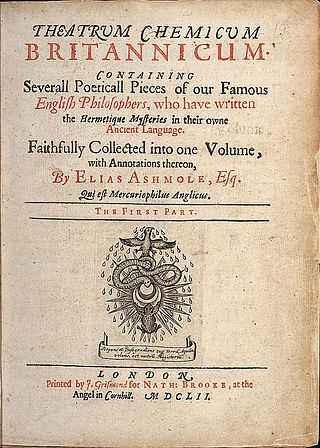
Theatrum Chemicum Britannicum first published in 1652, is an extensively annotated compilation of English alchemical literature selected by Elias Ashmole. The book preserved and made available many works that had previously existed only in privately held manuscripts. It features the alchemical verse of people such as Thomas Norton, George Ripley, Geoffrey Chaucer, John Gower, John Lydgate, John Dastin, Abraham Andrews and William Backhouse.

The Squire is a fictional character in the framing narrative of Geoffrey Chaucer's Canterbury Tales. He is squire to the Knight and is the narrator of The Squire's Tale or Cambuscan. The Squire is one of the secular pilgrims, of the military group. The Knight and the Squire are the pilgrims with the highest social status. However his tale, interrupted as it is, is paired with that of the Franklin. The Squire is a candidate for the interrupter of The Host in the epilogue of the Man of Law's Tale.


















